Antique WMF Large Art Nouveau Punch Bowl Silver Plated Cut Glass with Stand Lid
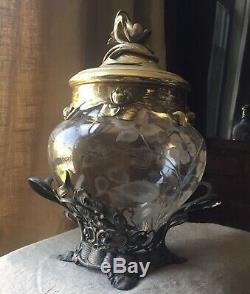

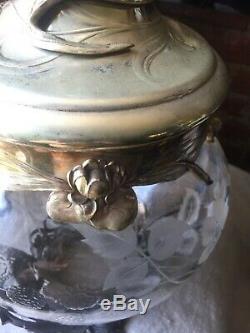
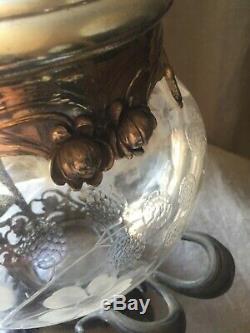

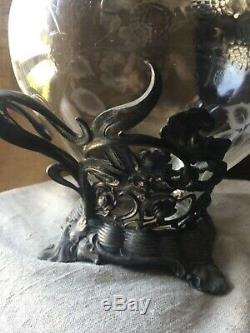
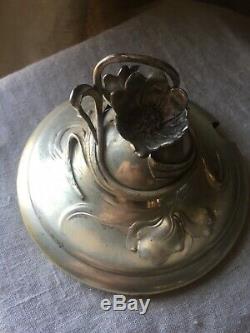
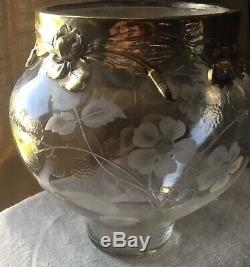
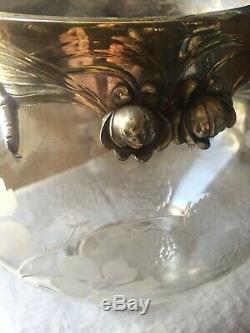
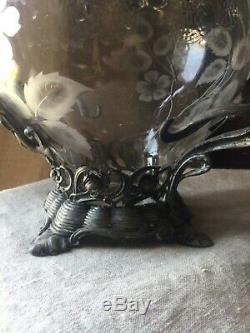
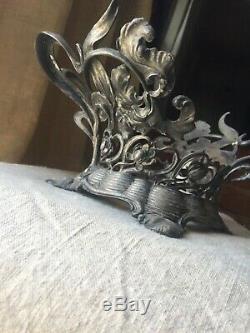
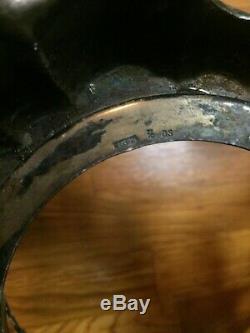

This is a magnificent German WMF Art Nouveau silver plated and cut glass centrepiece, circa 1890 in date. This stunning centerpiece or punch bowl features beautiful silver plated trim around the glass and a lid and fitted with a removable stand - very finely chased silver plated. The centrepiece stands on an elegant round base which is finely chased with foliage decoration and is raised on four exquisite foliate feet. The piece is fully hallmarked WMF (please see last picture). This is truly a special item that can be used and admired at the centre of a dining table.
The quality and craftsmanship here are undeniable. Condition: In really excellent condition.
Please see photos for confirmation. The glass bowl in great condition without chips or cracks and the same for the silver decoration and there are no breaks or dents but it had tarnished from being in an estate in Long Beach Long Island NY right on the water. This opulent silver and etched glass punch bowl is.The very epitome of Art Nouveau design. It has all the romantic elements- the swirling silver base, the delicate repoussé decoration on the lid and the graceful ladle. A pattern is lightly etched in the glass bowl and the finial on top will let you lift the lid with a flourish! WMF - WURTTEMBERGISCHE METALLWARENFABRIK: HISTORY In 1853, Daniel Straub, a miller from Geislingen, joined forces with the Schweizer Brothers to form the "Metallwarenfabrik Straub & Schweizer" in Geislingen.
This was the second company to be founded by Straub - previously in 1850, from the nucleus of a small repair workshop, which he had set up to work on the construction of Geislingen's famous railway incline, he had founded the Maschinenfabrik Geislingen. This company was involved mainly in manufacturing mill turbines and traded throughout Europe. As early as 1862, the young company distinguished itself by winning a gold medal at the World Exhibition in London. In 1866, following the departure of the brothers Louis and Friedrich Schweizer, the company was renamed Straub & Sohn (Straub & Son).
The company showroom, built in 1868 in Berlin, gradually evolved to become the company's first retail outlet. Three years later, the company was already employing 60 workers. By 1880, the number of employees had grown to approximately 200 and the company was already producing 960 different items. 1880 saw the merger between Straub & Sohn and Ritter & Co. , Esslingen, to form a public limited company under the name of Wurttembergische Metallwarenfabrik. At the time of the merger, Ritter & Co. S Esslingen factory was already using the electroplating method of silver plating and had the more modern production facilities at its disposal. Straub's company, on the other hand, was the more profitable of the two. 1892 saw the development of a special technique for silver plating cutlery, whereby the silver is distributed in a way that, at the points of the cutlery most exposed to wear and tear, the coating is twice as thick as elsewhere.This process was patented and is still in use today. Known nowadays as'Perfect Hard Silver plating' the technique remains exclusive to WMF. Under Carl Hugele the company gained international standing.
At the turn of the century the factory in Geislingen employed 3,000 workers. By 1910, this number had already grown to 4,000, making WMF the largest company in Wurttemberg at this time. Sales catalogues were printed in twelve languages. Subsidiary companies in London, Warsaw and Vienna opened up export markets. Under the direction of Albert Mayer the WMF studio was influenced by the art nouveau style.
The product range was modernized and considerably extended. In 1905 WMF acquired a majority holding of the Cologne company Orivit AG, which manufactured products from "Orivit", a tin alloy. As of 1925, products created by the Contemporary Decorative Products Department (NKA) made their debut on the market. This department was set up under the direction of Hugo Debach in order to establish the name of WMF amongst consumers interested in art and design. This department was responsible for producing the special "Ikora" finish, which has earned an important place in the annals of art history.
The "Ikora" brand name referred to a specific method of treating the surface of the metal, by which layers of coating were applied in a partly chemical and partly heat induced process. A host of newly developed hand-finishing techniques enhanced the possibilities for adding decorative flourishes to the products. Despite being mass produced, every item looked as if it had been individually crafted.
At the end of the war the company had lost its foreign assets, associated factories and retail outlets. The years following 1945 saw the start of a concerted effort to reconstruct in terms of personnel, organizational structures and technology in the remaining factory sites.The network of retail shops was rebuilt. Very soon, subsidiaries sprang up in the USA, Holland, Canada, Switzerland, Austria and Italy. By 1950, WMF staff numbers had again swelled to 3,000. Silverplated tableware and cutlery accounted for two thirds of WMF's turnover, with shops specialising in clocks and watches, gold and silverware representing the company's main customers.
A shift in emphasis occurred at the end of the 1950s and was marked by an increase in the importance of Cromargan cutlery and hollowware. This period saw the creation of classic products, such as designed by Wilhelm Wagenfeld, which still feature in or have been reintroduced into the WMF collection. It also saw an increase in the volume of trade in household and kitchenware items between WMF and specialist retail shops. A number of stemware collections completed the WMF catalogue, followed by the development of an extensive range of products for the hotel and catering industry.
By 1960, the Geislingen factory alone employed around 5,800 workers. A shortage of space and manpower at this site led to the setting up of additional branch factories, like the factory in Hayingen and Riedlingen. In 1901/02 they built a new factory in Köln- Braunfels and began with a revolutionary new press "the Huber Presverfahren" The factory has won several prizes: in Paris the gold medal at the world exhibition of 1900 in Dusseldorf in 1902 at the "Industrial Design Exhibition" and at the exhibition in St Louis (USA) 1904 they won 2 Grand Prix prizes and 1 gold medal. In 1905 the total financial collapse was a fact and the "Wurttembergische Metalwaren Fabrik" (WMF) bought ORIVIT.
They produced items with the name ORIVIT until 1914. In 1906 the designs from the "Metalwarenfabrik ORION" became ORIVIT. WMF realized under the mark Ikora Edelmetall a wide production of items in geometric style inspired to Art Decò and to Japanese Art in brass and nickel hand-decorated with enamel applied by fusion to the surface of the metal. The item "Antique WMF Large Art Nouveau Punch Bowl Silver Plated Cut Glass with Stand Lid" is in sale since Friday, July 26, 2019. This item is in the category "Antiques\Silver\Silverplate\Bowls".The seller is "antikl0ver" and is located in Ridgewood, New York. This item can be shipped to United States, United Kingdom, Denmark, Romania, Slovakia, Bulgaria, Czech republic, Finland, Hungary, Latvia, Lithuania, Malta, Estonia, Australia, Greece, Portugal, Cyprus, Slovenia, Japan, Sweden, South Korea, Indonesia, South africa, Belgium, France, Hong Kong, Ireland, Netherlands, Poland, Spain, Italy, Germany, Austria, Bahamas, Israel, Mexico, New Zealand, Singapore, Norway, Saudi arabia, Ukraine, United arab emirates, Qatar, Bahrain, Croatia, Malaysia, Panama, Jamaica, Jordan, Peru, Paraguay, Viet nam, Uruguay.
- Style: Art Nouveau
- Age: 1850-1899
- Pattern: American Victorian
- Brand: WMF
- Type: Bowls
- Composition: Silverplate

